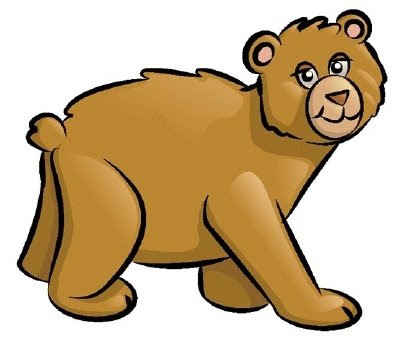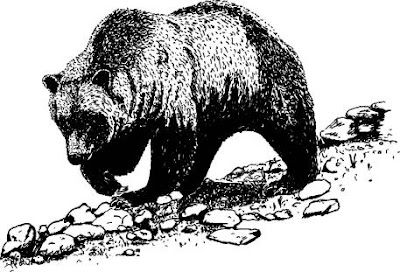I had just turned twelve, so it was late 1959. My father took me with him on a hunting trip with several men he knew. All he and I did was walk around on a freezing mountaintop in Utah until we heard shots. Nobody saw a deer that day, but one fellow had surprised a bear. It charged, so he shot it.
All of us took some meat, and the shooter took the skin. The rangers we contacted measured the carcase and skin. The bear was the largest black bear shot in Utah by that date, at 7'-7" (or 2.3 m). Its estimated weight was 550 pounds (250 kg). No license was needed to shoot a bear at that time, as they were not a popular target and were abundant. By the way, I've butchered a few animals in my time, mainly deer. You can take a deer apart with a knife. For this bear, Dad and his friends used an axe to separate the joints.
I have a copy of a painting that used the bear's skin as a rug for an old Mountie showing off his trophies to a visiting grandson.
 Does this picture show what most of us think when we think of bears at all? Take a careful look: the flat face, friendly smile, high forehead, well-rounded body, clawless paws...we know it is a caricature, but just how distorted is this image? To find out, read Bears: A Brief History by Bernd Brunner, translated from German by Lori Lantz. The word "history" is fraught with misleading connotations; here it really means "history of human-bear relations".
Does this picture show what most of us think when we think of bears at all? Take a careful look: the flat face, friendly smile, high forehead, well-rounded body, clawless paws...we know it is a caricature, but just how distorted is this image? To find out, read Bears: A Brief History by Bernd Brunner, translated from German by Lori Lantz. The word "history" is fraught with misleading connotations; here it really means "history of human-bear relations". In his Acknowledgements, Brunner mentions recasting the book for a mainly American audience with Ms Lantz's help. I reckon the German edition is more Euro-centric.
 This more accurate drawing of an American Brown Bear ("Grizzly") shows how bad the caricature is. The bear's face is as long as a dog's, in proportion, it can no more smile than it can sing, its claws—as long as your fingers—cannot be retracted, and its midsection is relatively narrow. This is one lean, strong animal. This image is copied from the Grizzly page of the Internet Center for Wildlife Damage Management.
This more accurate drawing of an American Brown Bear ("Grizzly") shows how bad the caricature is. The bear's face is as long as a dog's, in proportion, it can no more smile than it can sing, its claws—as long as your fingers—cannot be retracted, and its midsection is relatively narrow. This is one lean, strong animal. This image is copied from the Grizzly page of the Internet Center for Wildlife Damage Management.While a large black bear can weigh up to 250 kg, brown bears in the "lower 48" are similar size, but in Alaska and Canada they can exceed 400 kg. Then throw on another 50-100 kg, for any bear, of late fall fat, and they go into hibernation very heavy indeed.
There are eight species of bear, and all are now either endangered or close to it. Most Endangered Bears Ranked page at National Geographic Society has brief information on all of them, and their status. No bear species is currently a shoo-in for survival to the end of this century.
But it is the history leading up to this point that interests author Brunner. Had there been native great apes (other than humans) in medieval and renaissance Europe, and later America, I wonder if so much legend and myth would surround bears. No European or American saw a gorilla or chimp prior to the 18th Century. Thus the black bear (more rarely brown bear, meaning the Grizzly), being the only large animal that was frequently seen standing, became a stand-in for human archetypes.
To some earlier peoples, bears were gods; to others they were prey; and to others, they were competitors. The relationship was often complex; nobody is neutral about bears. This makes it rather hard for us to imagine, to realize, that they have nearly no interest in us. Curiosity is needed by highly social species such as ourselves. For a mainly solitary bear species, curiosity deeper than "how do I get food out of that over there?" is a distinct handicap. Bears only tolerate one another for a week or so around mating time, and it is only male-female toleration. Same sex encounters lead to avoidance or fights. Period.
Of course, most people immediately think "...lonely existence..." but bears can't feel loneliness. They are best adapted to, and quite happy with, almost total solitude for 50-51 weeks yearly. Where several bears find themselves in one area because of a concentration of food (salmon runs, for example), they ignore one another.
To me, the key message of Brunner's book is that bears aren't "big people". They are really unlike us in nearly all ways. In the past few thousand years, humans have made a few bear species extinct and driven the rest close to extinction. While many thousands have been killed for food, medicine and skins, many more died because their forests were cut down for grain fields. Only at the very edges of human-bear habitat do we find bears entering human territory, and that is usually because a bear is starving.
A black bear needs a home range of a couple square miles, say 1000 acres (400 hectares). When land in a forest gets dissected into pieces smaller than this, bears have to cross from piece to piece to find food. If your neighborhood is between to small patches of forest, don't be surprised to find your hard an occasional bear thru-way. If your flimsy garbage can is on that thru-way, expect it to be raided.
It is bad enough that we've made bears dance for us, ride circus horses, and go stir-crazy in zoos. We are crowding them out of their territory, in every place they can live. Good bear habitat is also good human habitat. But, as the author says, "...the greatest threats to bears may be our own perceptions of them. What cultural filters distort how we see bears today?" To most people, "good bears" don't seem to eat, except when you throw something to one in the zoo.
If you see a bear "in the wild", or even on your yard, it is looking for food. You are probably not the kind of food it is looking for. But if you get between it and food, you stand little chance of escaping harm. A bear doesn't care about you. We "cutify" bears and claim to care about them. Good. Care for them by making sure you don't tempt them with your garbage, nor buy homes in former bear habitat.



No comments:
Post a Comment